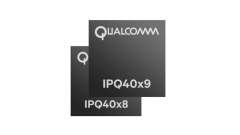IPQ40x8 and IPQ40x9 From QUALCOMM

New 802.11ac SoC Components IPQ4018/19/28/29
For several product generations, QUALCOMM has been developing WiFi SoC (system-on-chip) components, which also integrate a network and an application processor in addition to the radio function. These components were previously based on an MIPS CPU with either a 24Kc or a 74Kc architecture.
With the IPQ4018/19/28/29 component family, QUALCOMM is taking a completely new approach, offering SoC solutions featuring a Cortex-A7 CPU for the first time. The developers opted for 4 processor cores from the outset, and each core comes with a floating point unit, a NEON data engine, 32 KB I-cache, and 32 KB D-cache.
In addition, all 4 cores have access to a shared 256 KB L2 cache. Considering that each core can be clocked at 710MHz (or 716.8 MHz in the case of IPQ40x9), one quickly realizes that these are really powerful devices allowing for the integration of highly complex applications.
Two WiFi Radios Integrated in Parallel
In practice, 2 cores are often assigned to network protocols, and 2 to the application. For those who believe that two cores are too much for the network, it should be pointed out that each component supports dual band and real dual concurrency (DBDC) for the 802.11ac @ 5GHz and 802.11n @ 2,4 GHz standards, i.e. both frequencies can be served simultaneously, which always requires that two WiFi radios (MAC and PHY) are integrated in parallel.
An additional feature of these devices is that they support the MIMO 2x2 antenna configuration for 11n, and the MU-MIMO 2x2 for 11ac. The latter has a modulation of 256 QAM, a 5/6 coding rate, and a maximum bandwidth of 80 MHz, reaching a raw data rate of 866.7Mbps. For 802.11n, the device supports a raw data rate of 300Mbps for 802.11n at a maximum bandwidth of 40MHz.
In addition, the 11n radio in the IPQ40x9 can also be configured as 11ac, so that it can operate two 11ac radios with MU-MIMO 2x2 in dual concurrency. Both components also feature a PCIe interface, allowing for a third radio to be added. In the IPQ40x8, the additional radio (just as in IPQ40x9) can be connected via USB2.0 and USB3.0. In general, several additional interfaces are available. One should particularly emphasize the 5-port gigabit Ethernet switch and the 16-bit DDR3L interface with a speed of up to 672MHz. The two components IPQ4018 and IPQ4019 are also available in an enterprise version as IPQ4028 and IPQ4029. The IPQ4029 is the only component of the family that also supports the extended temperature range of -40°C to +110°C (case).
WiFi SON Support
Our module partner 8DEVICES has already announced that it will be launching a module based on IPQ4018 in the course of this year. 8DEVICES is already testing the first engineering samples. Finally, it should be pointed out that the entire component family supports the new WiFi SON (Self-Organizing Network) by QUALCOMM. WiFi SON allows for several network processes for routers, gateways, and access points to be automated, such as, for instance, self-configuring, self-managing, self-healing and self-defending.
Your Contact Person
For more information please contact André Ehlert.

